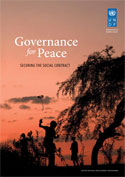 With fragile states rising to the top of the international policy agenda, thinking on fragility has evolved across a range of actors. Last year alone saw the launch of several landmark policy reports, from the OECD DAC’s “Supporting Statebuilding in Situations of Conflict and Fragility,” to the “World Development Report 2011: Conflict, Security and Development.” Both are the culmination of years of academic and practical investigation into how international actors need to amend their practices to address the unique challenges posed by conflict and state fragility.
With fragile states rising to the top of the international policy agenda, thinking on fragility has evolved across a range of actors. Last year alone saw the launch of several landmark policy reports, from the OECD DAC’s “Supporting Statebuilding in Situations of Conflict and Fragility,” to the “World Development Report 2011: Conflict, Security and Development.” Both are the culmination of years of academic and practical investigation into how international actors need to amend their practices to address the unique challenges posed by conflict and state fragility.
These messages were embraced by participants of the International Dialogue on Peacebuilding and Statebuilding, which, at the Fourth High Level Forum on Aid Effectiveness in Busan in November, presented a “New Deal for Engagement in Fragile States.” Endorsed by 36 countries and multilateral organizations, the New Deal sets out five peacebuilding and statebuilding goals–legitimate politics, security, justice, economic foundations, and revenues and services–to guide national and international efforts in conflict-affected and fragile states.
However, translating these policy agreements into changes on the ground will be challenging. The 2011 independent evaluation of progress made in implementing the Paris Declaration and the monitoring survey on the Fragile States Principles indicated that donors are falling short of their existing commitments. Many of the concepts embraced by these new policy instruments–a focus on legitimate institutions, inclusive political processes, and resilient state-society relations–are new and difficult concepts for international development agencies to grapple with, and implementing them will require fundamental shifts in both thinking and practice.
Against this background, UNDP has just released a new report, “Governance for Peace: Securing the Social Contract.” Based on an inventory of UNDP policy and programming experiences in fragile and conflict-affected settings, the report aims to provide a framework for governance promotion in situations of fragility and conflict that can serve as a platform for future development programming.
Practitioners looking for a blueprint for programming or a set of prescriptions will not find them here. In fragile contexts, where interventions are deeply political and must be tailored to the local context, no such blueprint exists. Instead, the report sets out four objectives to guide assistance, with a menu of priorities and activities under each. The framework is consistent with the guidance found elsewhere, highlighting the need to invest in responsive institutions, foster inclusive politics, improve resilience of society to crisis, and work through partnerships.
As we know, the stakes are high. Globally, 1.5 billion people live in countries affected by violent conflict. International aid to fragile and conflict-affected states accounts for 30% of global official development assistance flows. However, no low-income fragile or conflict-affected country has yet to achieve a single Millennium Development Goal.
The priorities presented here are a good framework through which to approach governance programming, and the report offers many interesting real-world examples, but the devil is always in the details. The challenge for UNDP, and other actors, will be in ensuring that the whole of its governance activities in fragile states are greater than the sum of its parts.




